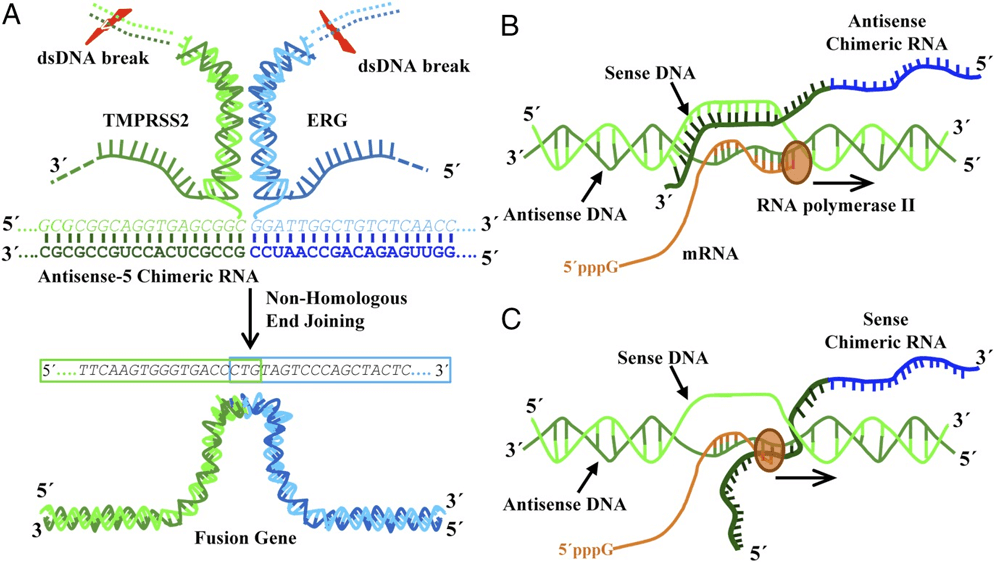Transcriptional Analysis of Gene Fusions in Cancer
Transcriptional Level Gene Fusion Analysis and RNA-mediated Fusion
Fusion genes are among the most cancer-specific molecular signatures known to date and are important for understanding cancer mechanisms and developing useful clinical biomarkers and anticancer therapies. The DNA-level detection of gene fusions is extensive, demonstrating the presence of rearrangements and structural variations occurring on chromosomes. In recent years, researchers have paid more and more attention to the relationship between fusion genes and transcription. Fusion gene formation due to chromosomal translocations has been reported to occur prior to fusion RNA expression, and there have been reports of fusion transcripts in individuals with no detectable fusion gene at the genomic DNA level. RNA-mediated gene fusion is a mechanism that relies on sequence-specific interactions to account for the "specificity" of genes selected for gene fusion. The difference between the presence of fusion transcripts and the absence of fusion genes may be limited by the detection limitations of the method used. But fusion transcripts in normal cells may also result from RNA trans splicing in the absence of chromosomal translocations. Our FISH technology platform provides relevant molecular testing services for the confirmation that a specific fusion gene in cancer is the original source of the transcribed chimeric RNA.
 Fig 1. A model of RNA-mediated gene fusion in mammalian cells. (Sachin Kumar Gupta, et al. 2018)
Fig 1. A model of RNA-mediated gene fusion in mammalian cells. (Sachin Kumar Gupta, et al. 2018)
Visualization Analysis Service for Chimeric RNAs
In tumor samples, the production of chimeric RNAs may directly originate from transcriptional mechanisms such as "trans-splicing" and "read-through/splicing" and further influence cancer development. At the same time, the source of chimeric transcription also includes a direct transcription from the fusion gene. RNA-mediated gene fusion in mammalian cells has received increasing attention from researchers. The study of this issue is important for addressing specific questions about fusion gene formation in cancer and may have implications for the biology of mammalian genome stability and gene editing via mammalian cell-native mechanisms. For single-cell level analysis of transcripts produced in gene fusions or localization in histological contexts, we offer comprehensive in situ visualization solutions. After continuous testing, our molecular testing platform has formed a testing service model that is compatible with a variety of commercial probes, and accepts testing services for products specified by customers. At the same time, we have the ability to design a variety of synthetic probes and provide customization of comprehensive customized test solutions.
Applications
Transcriptional analysis of fusion genes in cancer, including RNA, co-expression analysis of RNA and fusion proteins;
Studies of clipping mechanisms that generate chimeric RNAs, such as trans clipping. In human tumors, trans-splicing events may precede chromosomal rearrangements, and there is even the notion that trans-splicing molecules can act as "guides" to facilitate genomic translocation.
Research on gene fusion and RNA-mediated fusion;
 Fig 2. FISH Assay for Transcriptional Analysis of Gene Fusions in Cancer.
Fig 2. FISH Assay for Transcriptional Analysis of Gene Fusions in Cancer.
Creative Bioarray's in situ visualization solution can be used for further analysis of the transcripts of fusion products in gene fusions, helping customers to easily visualize RNA targets in the tissue context in cancer-related gene fusion studies. Our RNA-FISH assays rely on many well-established commercial probes or custom probes, and you will benefit from our technical expertise and complete platform. If you are interested in our services, please contact us for cooperation. We look forward to cooperating with you in the near future.
References
- Gupta, Sachin Kumar, Liming Luo, and Laising Yen. "RNA-mediated gene fusion in mammalian cells." Proceedings of the National Academy of Sciences 115.52 (2018): E12295-E12304.
- Gupta, Sachin Kumar, Jocelyn Duen-Ya Jea, and Laising Yen. "Validating Gene Fusion as the Source of Chimeric RNAs." Chimeric RNA. Humana, New York, NY, 2020. 187-207.
All products and services on this website are only suitable for non-medical purposes.


 Fig 1. A model of RNA-mediated gene fusion in mammalian cells. (Sachin Kumar Gupta, et al. 2018)
Fig 1. A model of RNA-mediated gene fusion in mammalian cells. (Sachin Kumar Gupta, et al. 2018) Fig 2. FISH Assay for Transcriptional Analysis of Gene Fusions in Cancer.
Fig 2. FISH Assay for Transcriptional Analysis of Gene Fusions in Cancer.


